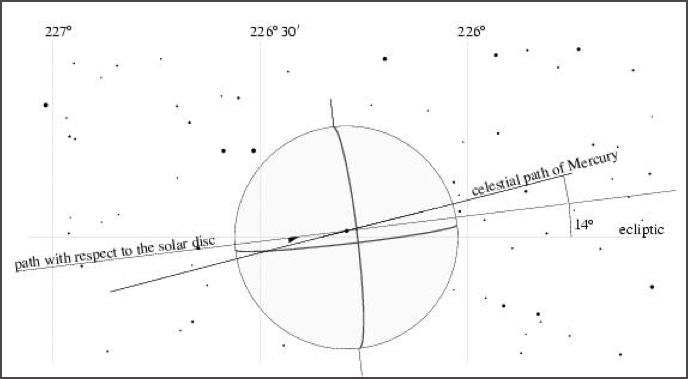Introduction
The seal of the Royal Philosophical Society of Glasgow is thought to depict the transit of Mercury (across the face of the Sun) that occurred on 9 November 1802 – the day of the first meeting of the Society.
Figure 1: Seal detail. The position of Mercury corresponds to a time of about 1000 UT.
The centre of the design on the seal (Figure 1) appears to show two lines across a solar disc making an angle of approximately 15°. The slanted line is clearly labelled with the symbol for Mercury and has a smaller disc upon it, offset from the centre. The other line is not labelled. Around the solar disc are 60 radial rays, 6° apart. The unlabelled line across the solar disc does not quite align with any of these rays, being rotated anticlockwise by about 3° around the central axis.
Interpretation
The appearance of the 1802 transit was reconstructed using the commercial software package Starry Night Pro (v 3.0.2, Sienna Software). The task was well within the quoted accuracy of the software, and the predicted time of central transit (0859 UT) agrees with that from the JPL DE406 Ephemerides for this transit. For completeness, the viewing location was taken as Glasgow.
The transit began at 0616 UT on the morning of 9 November, well before sunrise (0742 UT). Local noon was at 1201 UT. The transit ended at 1141 UT that morning, and at the mid point of the transit Mercury was very close to the centre of the solar disc. This central instant is depicted in Figure 2, showing the position of Mercury and the Sun at 0859 UT with respect to (unobserved!) background stars in the constellation of Libra. The Sun at this point is at RA 15h 6m.34, dec 17° 30?.3 (J2000), and is shown with its rotation axis, equator and prime meridian for reference. The other lines crossing the solar disc are the ecliptic (taken as roughly the celestial path of the Sun), the celestial path of Mercury and the path of Mercury with respect to the solar disc. This last line needs some explanation. The Sun is moving right-to-left with respect to the background stars, and Mercury is moving left-to-right. The vector difference represents the apparent motion of Mercury across the solar disc, and therefore the view an observer would see if tracking the Sun with a polar-mounted telescope.
Figure 2: The solar disc at 0859 UT on 9 November 1802, as seen from Glasgow. The verticals show lines of constant ecliptic longitude.
The diagram shows that the angle between the ecliptic and the celestial track of Mercury is approximately 14°. If an observer has written down the right ascension and declination of Mercury and of the Sun during the transit and plotted these, the two tracks would have made an angle of 14°, close to the 15° measured from the seal. However the apparent path of Mercury with respect to the Sun subtends a much shallower angle with the ecliptic, so it is unlikely the seal accurately depicts the transit as it would appear to progress to a casual observer.
It is not obvious that the horizontal line across the solar disc represents the ecliptic, however lines of constant altitude (as seen from Glasgow) and of constant declination both subtend too great an angle to either path of Mercury to work, so the ecliptic appears the best choice.
Conclusion
The angle between the lines on the seal corresponds well with that between the celestial tracks of the Sun and Mercury during the transit. It is therefore consistent with a retro-calculation of the transit from an ephemeris. It does not, however, accurately represent the track of Mercury across the disc.
The 3° deviation of the ecliptic with respect to the rays does not seem to have any significance, as the computed solar rotation axis appears tilted by 7° to a line of constant ecliptic longitude. The size of the planet is also greatly exaggerated. At 10 arcsec, it would appear as only 1/192 times the apparent diameter of the Sun.
Graham Woan
8/2000
A recent transit of Mercury
Figure 3: time lapse of the transit of Mercury on 15th November, 1999
Credit: TRACE Project
Figure 4: movie
Credit: Brian Handy (Montana State Univ.),




